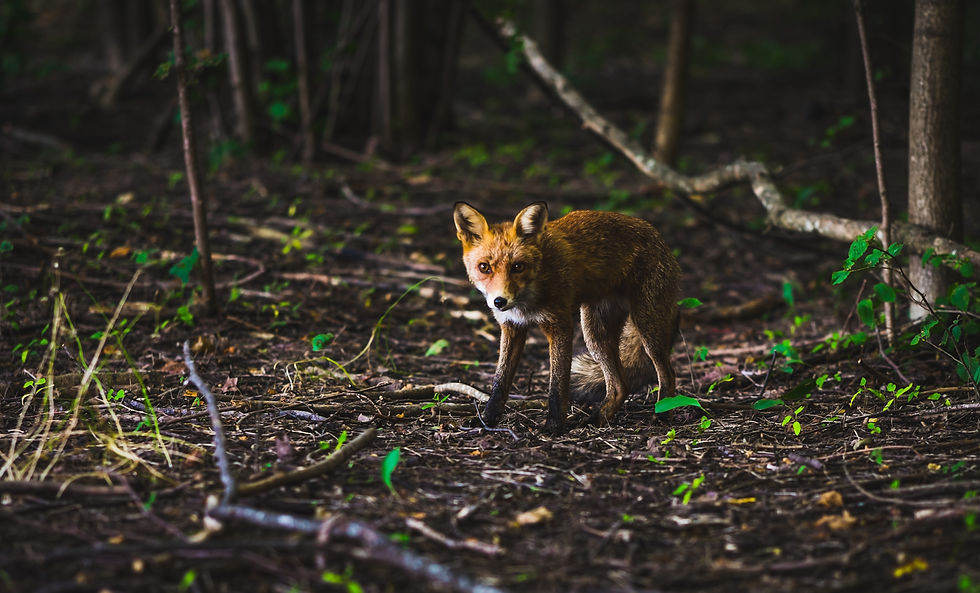
Fox Control & Removal
The red fox (Vulpes vulpes) is a common species of fox found throughout the world, including in urban environments. Urban foxes, in particular, are a common sight in many cities and towns, and are known for their adaptability and resourcefulness.
In urban areas, foxes may feed on a variety of food sources, including garbage, pet food, and small animals such as rodents and birds. They may also den in urban areas, such as under sheds, decks, or in other sheltered areas.
While foxes can provide some benefits to urban ecosystems, such as controlling rodent populations, they can also cause problems for homeowners and businesses. Foxes can dig holes in lawns and gardens, damage property, and spread diseases such as rabies and mange.
To control fox populations in urban areas, a number of measures can be taken. These may include removing sources of food and shelter, such as securing garbage cans and compost bins, and sealing off potential den sites. In some cases, humane trapping and relocation may be necessary to remove individual foxes from an area
To find our more about what we do and how we can help please Get In Touch or call us on 03333 391 816.

Fox Damage & Disease.
Foxes can cause damage to livestock, poultry, and property, particularly when their populations are high. Some of the common types of damage caused by foxes include:
-
Predation: Foxes are known for their ability to prey on small livestock and poultry, such as chickens and rabbits, causing economic losses to farmers and backyard owners.
-
Property damage: Foxes can cause damage to property, such as digging up gardens, lawns, and landscaping, as well as chewing on irrigation systems and outdoor furniture.
-
Disease transmission: Foxes can carry diseases such as rabies and mange, which can be transmitted to other animals or humans.
To prevent fox damage, some methods include:
-
Fencing: Installing a sturdy fence around the area to be protected can be effective in keeping foxes out.
-
Lethal force
-
Habitat modification: Removing brush piles, tall grasses, and other potential fox habitats can discourage foxes from taking up residence in the area.
-
Trapping: Live traps or lethal traps can be used to capture or remove foxes.
It's important to note that some of these methods may only be temporary solutions, and ongoing maintenance may be required to keep fox populations under control.
Fox Control & Removal.
ServLabs Pest Control provides experienced Fox control and removal services to protect your home or business. Our team of experiencedprofessional technicians use advanced trapping techniques to effectively reduce and eliminate Fox populations. We also provide exclusion services to help prevent future Fox problems.
Our commitment to customer satisfaction ensures that all of our Fox control and removal services are performed in a safe and responsible manner.
Our team is available 24/7 to provide the best Fox control and removal services in the area. Contact us today to learn more about our Fox control and removal services.

Appointments Available Today
Our Local Team:
Contact numbers 03333 391 816
Email: PestControl@ServLabs.co.uk

Foxes Life cycle.
The life cycle of a fox begins with mating, which typically takes place in the winter months. Foxes are generally monogamous and will mate for life. After a gestation period of around 50 to 55 days, the female fox gives birth to a litter of pups, which usually consists of 4-6 individuals.
The pups are born blind and helpless, and rely on their mother for nourishment and protection. The mother will stay with the pups in the den for the first few weeks of their lives, nursing them and keeping them warm.
As the pups grow, they begin to venture out of the den and explore their surroundings. The mother will continue to care for and protect her young until they are old enough to fend for themselves.
At around 6 months of age, the young foxes will begin to hunt and forage for food on their own. They may leave their family group and establish their own territories as they mature.
Foxes typically live for 3-4 years in the wild, although they can live up to 14 years in cities. During their lives, they will continue to mate and produce offspring, contributing to the ongoing cycle of life for this resilient and adaptable species.









